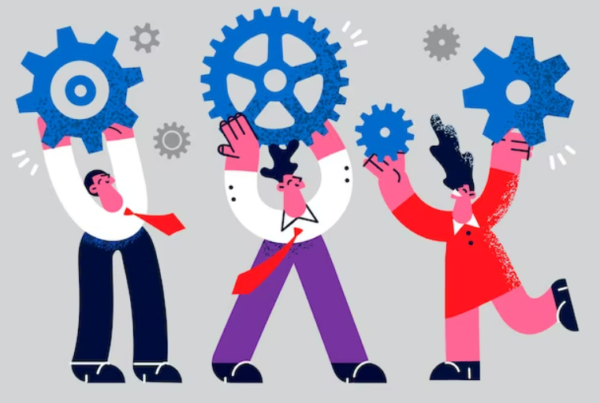Digital & Dispersed
Covid-19’s arrival prompted a change from on-site to remote working. This shift altered the way we worked and where we worked. The hybrid approach is the result of a combination of office-based work prior to the pandemic and Covid-induced flexible, remote work patterns. Many workers now support a hybrid strategy.
A hybrid team is defined as a collaborative group of professionals scattered across multiple locations and mediums who work according to flexible schedules. This post-covid hybrid team is dynamic, diverse, dispersed, and digital.
Hybrid teams have some advantages, such as more flexibility and reduced commuting times, but they also pose a number of challenges for managers.
Location Bias
This is a tendency to offer people in our local space preferred treatment; we unconsciously favor whatever is closest in time, space, and ownership while undervaluing that which is out of sight. Because of their proximity, supervisors will give office-based staff preferential treatment. Collocated employees give managers at the office the impression that they are working longer and harder. As a result, they assume that office workers are more productive and competent.
Passive face time is enough for people to make conclusions about what you’re doing and how well you’re doing it, which is known as the presence bias As a result, managers tend to favor office-based staff and may end up micromanaging remote workers.
Team Connection
Because the proximity bias and presence effect thrive when people are out of sight and out of mind, managers can use a team connection review to prevent this. On a daily or weekly basis, this entails analyzing which team members managers spoke with, for how long, and the quality and content of the interaction. They can then observe whether they spend more time with coworkers or remote workers, revealing any prejudices. The frequency and quality of conversation with specific employees can then be altered by managers.
Roles, Responsibilities & Feedback
Employee duties and responsibilities changed as a result of the shift to remote work, and they may change again as a result of the movement to hybrid working. Employees and employers who define their work design know exactly what to expect from each individual and can judge outputs correctly.
Tribalism
Individuals no longer regard their team as a cohesive and homogeneous unit, but rather as a collection of subgroups, thanks to the new hybrid character of teams.
To make sense of this complex environment, our brains categorize people using cognitive shortcuts. As a result, the key issue of ingroup prejudice arises. We categorize objects into categories like office employees and remote workers. Through this process of social classification, we divide the world into us and them. We adopt the identity of the group into which we were placed and act in accordance with it. We compare our group to other groups after it has been classified, accentuating the similarities within and disparities between them. An ingroup and an outgroup are formed as a result of this.
Office-based workers create an ingroup, whereas remote workers either get alienated or constitute the outgroup.
As a result, the distant outgroup in hybrid teams may face negative preconceptions and disadvantages while office-based workers benefit.
Meetings
Routine team meetings that bring all team members together on one platform to discuss personal matters, team values, and goals foster a feeling of shared identity. Individuals recognize their commonalities and categorize themselves as members of the team, resulting in the formation of a new, larger group membership. Local ingroups and remote outgroups are avoided and dismantled at these gatherings. Longer, more casual gatherings can result in a stronger sense of group identity.
Bias Awareness Training for Managers
Raising awareness of ingroup bias gives managers the tools they need to recognize when they’re falling prey to it in their decision-making and daily interactions.
Cohesion of the Team
Team cohesion can be defined as a group’s ability to work together as a unit. Social relations, task relations, perceived unity, and emotions are the four components that make up team cohesion. Interpersonal attraction is critical to team cohesion, and a cohesive team has strong relationships that bind people to the group as a whole.
Managers are concerned about team connectivity and collaboration. Cohesive teams have high collective efficacy and coordinate individual efforts to meet collective goals, as evidenced by task relations. Perceived unity shows that team members regard themselves as a unified unit with a shared identity and a sense of belonging. Finally, emotional cohesion demonstrates a sense of belonging and team spirit.
Hybrid teams have low cohesion because their geographical separation hinders the establishment of relationships and attraction, subgroups and ingroup bias obstruct emotions of belonging, and a sense of community and group identification are required to coordinate efforts toward a common purpose. Hybrid teams have the lowest level of cohesion among all teams. Stress and anxiety among coworkers and team members result from a lack of team cohesion, which lowers team effectiveness.
Working from home can leave employees feeling less connected to their teams, indicating that cohesion is a big concern for managers as they navigate the new hybrid work landscape.
Connecting Hybrid Teams
Managers can take critical activities to prevent the dissolution of team cohesion in the transition to hybrid teams.
- Team Mindset is important. Connect the team with a virtual team building event.
- Providing common direction and goals fosters employees’ feeling of community, group identification, and the urge to collaborate for common aims. It increases task relationships as well as emotional cohesion.
- To avoid location-based subgroups, make sure project teams contain both remote and in-office personnel.
- Employ a rewards system that reinforces high performance, task-relevant data availability, project-related training, and job-central material resources in a supportive atmosphere.
- Shared mindset: Today’s hybrid teams are highly vulnerable to us v them thinking and ingroup formation due to distance, diversity, digital communication, and shifting membership. As a result, building a shared attitude and fostering a common identity is the solution for improving team cohesion and preventing ingroup prejudice.
- Managers must make sure that each subgroup feels appreciated for its contribution to the team’s objectives. As this commonality amongst subgroups provides a sense of shared identity, a clear common objective must be established. Because both the ingroup and outgroup are recognized for their contributions, their sense of belonging to the group is increased, resulting in a new inclusive group membership that fosters cohesion because all members benefit from being an ingroup member. This fosters team cohesion.
Trust
Trust is a crucial component of all teams and organizations. High-trust organizations outperform low-trust organizations. This lack of trust among teams jeopardizes the seamless and efficient transition to hybrid working, since it decides whether employees will support or oppose managers’ plans for the transformation. Because employees with low levels of trust have a bad perception of their organization, the rapid and essential shift to hybrid working need high levels of trust in team supervisors to remove mistrust, cynicism, and sabotage.
- Managers should be informed about what they say, guarantee that their qualifications are acknowledged, be honest, and accept their mistakes.
- Managers should be dependable and follow through on their promises. This is especially true in the hybrid world when it comes to flexibility arrangements.
- Employees should feel comfortable disclosing personal information and speaking honestly with their managers. Managers should also self-disclose and actively listen in order to develop this.
- Self-awareness: Managers should be concerned about their employees, not simply about themselves and their agenda.
- Self-disclosure: Self-disclosure is a good way for managers to build trust in their hybrid teams and develop emotional trust among their hybrid team members. Self-disclosure, or sharing your motives, intentions, goals, values, and emotions, improves like and feelings of intimacy between managers and their teams, resulting in increased trust.
Get in contact if you need assistance managing hybrid teams.




